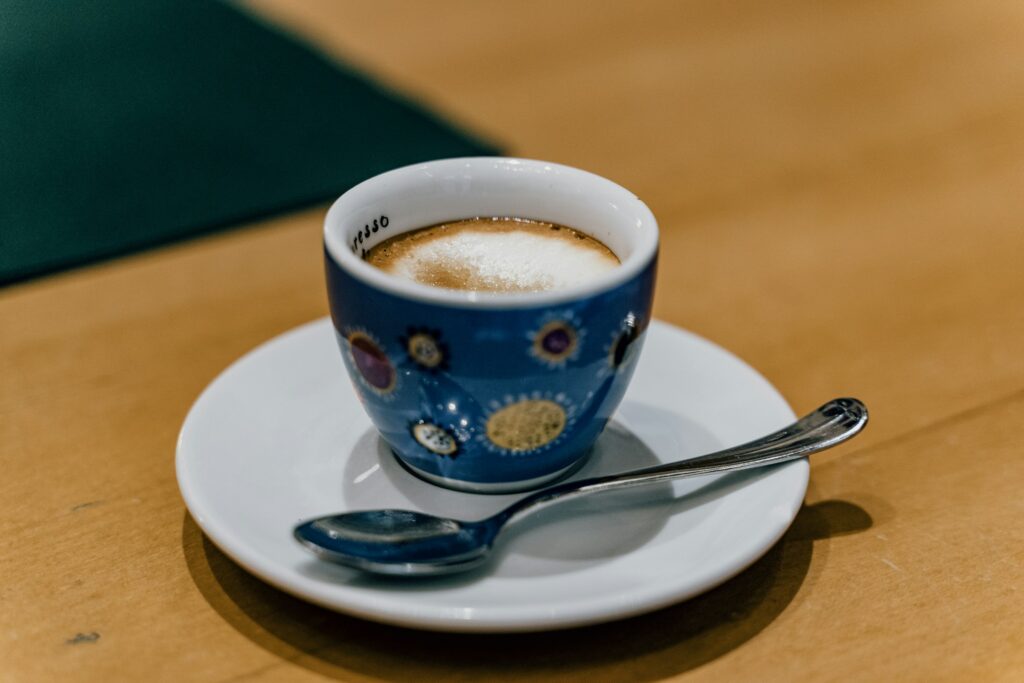Coffee may taste the same everywhere, but the way it’s enjoyed speaks volumes about culture. In Italy, a tiny espresso at the bar is a daily ritual, quick and intentional.
In the U.S., coffee often comes in giant cups, carried on the go, customized down to the last pump of syrup.
This post explores those contrasts—ritual versus convenience, tradition versus innovation, and why each approach says something bigger about how people live.
Historical Roots of Coffee in Each Country
Italy: Coffee as Ritual and Identity
In Italy, coffee isn’t just a drink, but it’s a cultural landmark. Espresso became the heart of Italian life after World War II, when small neighborhood cafés popped up as gathering places.
A single shot of rich, dark espresso wasn’t only about taste. It was about slowing down, greeting the barista who knows your name, and sharing a moment with neighbors.
Over time, the ritual of standing at the bar for a quick sip became a daily habit that defined Italian social life.
Even today, the idea of grabbing a to-go cup feels strange in Italy because coffee is meant to be savored, not rushed.
United States: Coffee as Energy and Expansion
In the U.S., coffee has long been tied to work and energy. Early diners made bottomless cups of drip coffee a staple, fueling truck drivers, night-shift workers, and anyone chasing the American hustle.
By the late 20th century, chains like Starbucks transformed coffee into an entire lifestyle brand. Suddenly, coffee wasn’t just about waking up—it was about choice, customization, and size.
Grande and venti became part of the vocabulary, and flavored lattes turned coffee into both a comfort drink and a personal statement.
In many ways, coffee in the U.S. mirrors the culture itself: fast-paced, bigger is better, and always adapting.
Types of Coffee Drinks
Italy: Simple, Strong, and Strict
In Italy, the menu is short and sharp. Espresso rules the game, with just a handful of variations like macchiato, cappuccino, and maybe a caffè latte. Each drink has a purpose and a time of day.
A cappuccino is for mornings only, never after lunch. Espresso? That’s fair game anytime. Italians treat coffee like art—measured, precise, and never drowned in syrups or whipped cream.
The focus is always on flavor and tradition, not novelty.
United States: Endless Choices and Customization
In the U.S., coffee has become a playground for creativity. Beyond drip and cold brew, there’s a dizzying menu of flavored lattes, frozen frappes, seasonal pumpkin spice, and every syrup under the sun.
Want oat milk, two pumps of caramel, and extra foam? No problem. Coffee here is less about rules and more about personal expression.
It’s a drink that can be tailored to mood, lifestyle, or even Instagram aesthetics.
The contrast is clear: Italy celebrates simplicity, while the U.S. thrives on variety. One values the purity of espresso, the other embraces coffee as a canvas for individuality.
The Role of Cafés
Italy: The Bar as a Daily Stop
In Italy, cafés—better known as “bars”—are woven into everyday life. They’re not places where you camp out with a laptop for hours.
Instead, they’re quick-stop hubs where locals step in, order an espresso, and drink it standing at the counter. It’s fast, social, and deeply personal.
Regulars are greeted like family, and the ritual creates a rhythm to the day. The café here is about connection, not convenience—more like a neighborhood kitchen than a workspace.
United States: The Coffee Shop as a “Third Place”
Across the U.S., cafés are designed for lingering. Coffee shops double as offices, classrooms, and hangout spots.
People spread out with laptops, meet for interviews, or chat with friends for hours over a single latte.
Chains like Starbucks turned this idea into a formula—comfortable chairs, Wi-Fi, and music that makes you want to stay.
Independent cafés added their own flavor, from hipster roasteries to cozy local spots.
The American café is less about a quick drink and more about creating space for work, community, and identity.
Daily Rituals and Timing
Italy: Precision and Tradition
In Italy, coffee follows an unspoken schedule. Morning starts with a cappuccino or caffè latte—always with milk, and always before 11 a.m. After that, milk-based drinks are a cultural no-go.
From lunch onward, it’s espresso only. Italians often stop for one mid-morning, another after lunch, and maybe a final shot in the late afternoon.
Each cup marks a pause in the day, not a marathon session. Coffee isn’t meant to last hours, but it’s a quick, intentional ritual that fits seamlessly into the daily rhythm.
United States: Anytime, Anywhere
In the U.S., coffee has no clock. A cup can appear at breakfast, during the commute, mid-afternoon, or even late at night during study sessions.
It’s often consumed in large sizes, sipped slowly while multitasking. Morning might start with a big travel mug filled to the brim, followed by an iced latte for the afternoon slump.
For many Americans, coffee is less about strict rules and more about staying fueled, whenever energy dips.
Portion Sizes and Presentation
Italy: Small but Mighty
In Italy, coffee is all about intensity, not quantity. The standard serving is an espresso in a tiny porcelain cup, often gone in two or three sips.
Even milk-based drinks like cappuccinos are small compared to American standards. There’s no giant to-go cup, no gallon of cold brew.
The presentation is simple, elegant, and focused on quality. Less volume, more flavor—that’s the Italian way.
United States: Bigger, Bolder, and Personalized
In the U.S., portion sizes lean toward the super-sized. A “small” can already be larger than an Italian cappuccino, and options like grande or venti take things further.
Coffee often doubles as a meal replacement, with add-ins like whipped cream, syrups, and caramel drizzle turning drinks into dessert-level creations.
Presentation is all about customization and convenience, whether it’s a drive-thru iced coffee in a plastic cup or a pumpkin spice latte topped with foam art for social media.
Social Meaning of Coffee
Italy: Connection in a Cup
In Italy, coffee is shorthand for community. Ordering an espresso at the local bar is as much about conversation as caffeine.
It’s where neighbors catch up, colleagues step out together, and strangers share a moment at the counter.
Even the quick ritual of standing shoulder to shoulder at the bar builds a sense of belonging. In many ways, espresso is Italy’s handshake: brief, warm, and universally understood.
United States: Coffee as Identity and Productivity
In the U.S., coffee often reflects personal style as much as taste.
Your order can say something about you—cold brew for the minimalist, oat milk latte for the health-conscious, pumpkin spice for the seasonal enthusiast.
Beyond identity, coffee also fuels the productivity engine. It’s the unofficial sponsor of late-night studying, early morning commutes, and back-to-back meetings.
While Italians drink to connect, Americans often drink to keep moving. Coffee here is less about slowing down together and more about powering forward individually.
Global Influence and Adaptation
Italy: The Espresso Standard
Italy’s influence on global coffee culture is impossible to miss. Espresso machines, cappuccinos, and lattes all trace back to Italian roots.
Walk into a café in Paris, Tokyo, or Cape Town, and you’ll find drinks built on the Italian model. Even when they’re adapted, the foundation remains the same—strong espresso at the core.
Italians often see themselves as guardians of “true coffee,” and debates about authenticity (like whether a cappuccino after lunch is a sin) still spark heated opinions worldwide.
United States: The Coffee Chain Phenomenon
The U.S. made coffee culture big, bold, and everywhere. Starbucks alone turned specialty coffee into a global movement, exporting its “third place” model to cities around the world.
American-style coffee shops introduced massive menus, flavored drinks, and the idea that coffee could be a full-blown lifestyle brand.
The U.S. also popularized the to-go culture, where carrying a coffee cup down the street became as common as wearing sneakers.
Love it or hate it, American chains reshaped how billions of people consume coffee.
Modern Shifts and Trends
Italy: Tradition Meets a New Generation
Italy has long held firm to its classic espresso rituals, but change is slowly brewing.
Younger Italians are showing more curiosity about specialty beans, latte art, and alternative brewing methods like pour-over or AeroPress.
While many older generations see these trends as unnecessary frills, new cafés are experimenting and blending tradition with modern tastes.
Sustainability is also entering the conversation, with some bars offering organic beans or fair-trade options.
Still, the essence of Italian coffee culture remains grounded in speed, simplicity, and connection.
United States: The Rise of Third-Wave Coffee
In the U.S., coffee has shifted from a commodity to a craft.
The “third-wave” movement—focused on sourcing beans ethically, roasting with precision, and highlighting flavor notes—has turned coffee into something closer to wine tasting.
Independent roasters thrive, specialty cafés highlight single-origin beans, and customers are more willing to pay for quality over quantity.
Trends like cold brew, nitro coffee, and plant-based milks have exploded in popularity.
Sustainability and transparency are also front and center, with consumers asking where their beans come from and how they were grown.
Together, these shifts show how both countries are adapting—Italy holding tight to tradition while cautiously exploring new flavors, and the U.S. leading innovation while pushing toward quality and ethics.
Final Words
Italy treats coffee as a ritual. The U.S. treats it as a variety and convenience. Neither approach is right or wrong—they simply reflect different ways of living.
One pauses for connection, the other powers forward with options.
In the end, coffee is more than caffeine. It’s a mirror of culture, identity, and daily rhythm!



